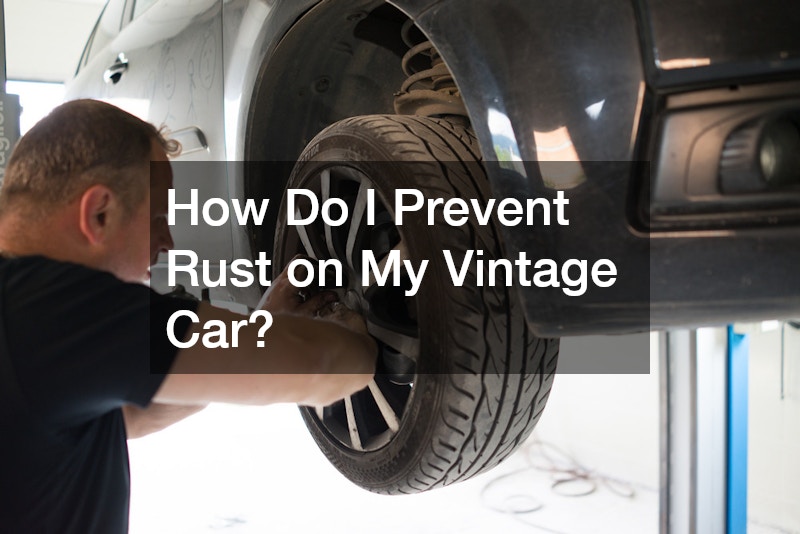Your old car has been a reliable companion—faithfully getting you from one destination to another through the years. Whether it’s a classic model you’ve restored, a family hand-me-down, or a trusted vehicle you’ve maintained for decades, keeping it running smoothly requires care, patience, and attention to detail. Unlike newer cars equipped with advanced electronics and self-diagnostic systems, older vehicles rely heavily on mechanical integrity and consistent maintenance to stay in good shape.
Regular upkeep not only helps prevent costly breakdowns but also enhances your vehicle’s safety and fuel efficiency. From monitoring engine performance to preventing rust and maintaining the interior, there are many small but significant ways to extend your car’s life. This comprehensive guide will explore the most frequently asked questions and provide effective strategies to help you protect your investment.
Whether you’re a casual driver or an automotive enthusiast, understanding how to preserve the performance, appearance, and value of your older vehicle can save you money and ensure many more years of reliable driving. Let’s take a closer look at how to keep your beloved car running as smoothly as the day you bought it.
How Often Should I Service My Old Car?

Routine servicing is the foundation of any well-maintained older vehicle. Over time, mechanical components wear down, seals degrade, and fluids lose their effectiveness. Regular service appointments can help identify issues before they escalate into costly repairs. For most older cars, experts recommend a full inspection every 3,000 to 5,000 miles or at least twice a year. Sticking to this schedule ensures that both major and minor systems receive attention before they have a chance to fail.
Scheduling digital vehicle inspections can make this process more accurate and transparent. These inspections use advanced software and imaging tools to provide detailed visual reports of your car’s condition. Technicians can pinpoint areas that need attention, such as worn belts, leaky gaskets, or corroded components, and show you photos or videos of the exact problem. This ensures you understand what’s happening under the hood and can make informed maintenance decisions. Additionally, digital reports create a valuable service history record that helps track your car’s condition over time—useful for planning repairs, budgeting maintenance costs, or even selling the vehicle in the future.
Keeping up with regular service intervals—oil changes, filter replacements, and fluid checks—will help your old car maintain optimal performance and longevity. Don’t overlook smaller items like windshield wipers, brake pads, and spark plugs, as these contribute to everyday reliability and safety. Consistent maintenance not only improves performance but also helps preserve your car’s resale value and ensures smoother, more enjoyable driving for years to come.
What are Essential Maintenance Tips for an Older Vehicle?
Owning an older vehicle means staying proactive about care and attention. Simple habits can dramatically increase your car’s lifespan and reliability. One of the most important steps is to schedule routine checkups with trusted auto repair services. Experienced technicians understand the unique needs of older vehicles and can recommend specific maintenance based on your car’s make, model, and age. They can also catch early warning signs of wear that might go unnoticed by the average driver, saving you from expensive repairs down the road.
Check and replace fluids regularly—engine oil, transmission fluid, brake fluid, coolant, and power steering fluid. Worn fluids can cause friction, overheating, and internal wear. Always listen to your car; unusual sounds, vibrations, or sluggish performance are signs something needs attention. In addition, inspect belts and hoses for cracks or fraying, as these parts can weaken with age and lead to engine failure if neglected.
Additionally, check your tires frequently for wear and proper inflation. Underinflated tires reduce fuel efficiency and increase strain on suspension components. Rotate your tires every 6,000 miles to promote even wear and extend their life. Replacing worn spark plugs, belts, and filters at recommended intervals helps keep your engine running efficiently. Don’t forget to clean battery terminals and check the alternator output to ensure dependable starting power. By following these essential tips, you can extend your car’s usability and maintain dependable performance on the road for many more years.
How Can I Improve the Fuel Efficiency of My Old Car?
Older cars are notorious for being less fuel-efficient than modern vehicles, but there are still ways to optimize performance and minimize gas consumption. Begin by maintaining proper tire pressure, as underinflated tires cause the engine to work harder. Regular oil changes using high-quality synthetic oil can also improve mileage by reducing friction.
Inspect your air filter and fuel system regularly—dirty filters or clogged injectors can drastically reduce efficiency. Tuning your engine and checking oxygen sensors can further enhance performance.
Cars equipped with automatic transmissions require special care, as transmission fluid plays a crucial role in both performance and efficiency. Ensure the fluid is clean and at the correct level; dark or burnt-smelling fluid may indicate the need for service. Driving habits also matter—avoid aggressive acceleration and excessive idling. Smooth driving not only saves gas but also puts less stress on the engine and transmission. With mindful maintenance and steady habits, you can help your older car use every drop of fuel wisely.
How Do I Prevent Rust on My Vintage Car?

Rust is the silent enemy of any aging vehicle. Once it sets in, it can spread quickly, compromising structural integrity and aesthetics. Preventing rust starts with regular cleaning and protective treatments. Wash your car frequently—especially during winter months when road salt accelerates corrosion—and dry it thoroughly.
A professional truck wrapping service can also help protect your vintage vehicle’s exterior. Wrapping not only enhances appearance but also acts as a barrier against moisture, salt, and UV damage. Apply rust inhibitors or wax-based sealants to the undercarriage, where corrosion often starts.
Inspect your car regularly for early signs of rust—bubbling paint, discolored patches, or soft spots—and address them immediately. Sand down affected areas, apply primer, and repaint to stop further damage. Keeping your car stored in a dry, climate-controlled environment will further reduce rust risk. With vigilance and care, you can preserve your car’s bodywork and keep it looking timeless.
What Should I Know About the Electrical System?
An older vehicle’s electrical system can be temperamental, especially as wiring and connections age. Flickering lights, inconsistent charging, or malfunctioning accessories can indicate wiring corrosion or a failing alternator. Routine inspection of your car’s battery terminals, fuses, and wiring harnesses is crucial.
When issues arise, professional technicians specializing in auto glass repair and electrical diagnostics can help identify shorts or grounding problems that may impact power systems. It’s also important to keep your battery clean and ensure secure connections to prevent voltage drops.
If your vehicle sits unused for extended periods, disconnect the battery or use a trickle charger to maintain its charge. Avoid overloading the electrical system with high-draw accessories unless your alternator can handle it. Regular maintenance of the alternator, starter, and voltage regulator ensures consistent performance and prevents unexpected breakdowns.
How Do I Keep My Old Car’s Interior in Good Condition?
An older car’s interior tells the story of its years—worn upholstery, faded trim, and cracking dashboards are common challenges. To keep your interior looking and feeling great, start with regular cleaning and conditioning. Vacuum seats and carpets weekly to prevent dirt buildup that can damage fabric fibers over time.
When deeper issues arise, a visit to your local car repair shop can help restore comfort and aesthetics. Many shops offer reupholstery services or can replace worn interior panels and weatherstripping. Use leather conditioner or fabric protectant to maintain material integrity and prevent fading from sunlight.
Avoid leaving your car exposed to direct sunlight for long periods—use sunshades and park in shaded areas whenever possible. Small touches like replacing floor mats, cleaning vents, and refreshing the dashboard can make an old car feel new again. Consistent care not only improves appearance but also enhances resale value.
What Are the Signs of Engine Trouble I Should Watch For?

Your engine is the heart of your car, and recognizing early warning signs can prevent major repairs. Listen for unusual noises—knocking, tapping, or grinding sounds often indicate problems with internal components. Excessive smoke, rough idling, or decreased power are also red flags.
A reliable auto alignments service can help detect mechanical imbalances that might cause additional strain on the engine. Misaligned wheels, for example, can increase resistance and reduce performance efficiency. Check for warning lights on your dashboard, inspect fluid levels, and monitor for oil leaks under the vehicle.
Regular engine diagnostics and compression tests can reveal developing issues before they cause damage. Replacing worn belts, gaskets, and filters on schedule helps prevent overheating and breakdowns. By staying alert to these warning signs, you can address engine trouble promptly and keep your car running strong.
How Can I Extend the Life of My Old Car’s Transmission?
The transmission is one of the most critical and expensive components to repair, so proper care is essential. Whether manual or automatic, it requires clean fluid and timely maintenance to perform reliably. Have your transmission fluid checked at least twice a year for proper color and consistency.
Experienced auto mechanics recommend flushing the transmission every 30,000 to 60,000 miles, depending on driving conditions. Dirty fluid or low levels can lead to poor shifting, slipping gears, or total failure. Avoid towing heavy loads or accelerating harshly, as this puts unnecessary stress on transmission parts.
Additionally, pay attention to how your car shifts. Delayed or rough transitions between gears may signal an internal problem that needs professional attention. Keeping your transmission in good health ensures smoother rides, better performance, and a much longer vehicle lifespan.
How Important Are Routine Brake Inspections?
Your brakes are your vehicle’s most important safety feature. Routine inspections are critical, especially as your car ages and components wear down. Over time, brake pads thin, rotors warp, and brake lines can corrode. Regularly checking and maintaining these elements ensures responsive braking when it matters most.
A local auto body shop can inspect your brakes during routine maintenance, measuring pad thickness and checking for leaks or air in the brake lines. Squealing or grinding sounds often signal that pads need replacement, while vibrations during braking may indicate rotor issues.
Brake fluid should also be replaced periodically, as moisture contamination reduces its effectiveness. Never ignore a soft or spongy pedal—it may point to a serious hydraulic problem. With consistent inspections, you’ll ensure your braking system performs safely and efficiently on every drive.
How Do I Keep My Old Car’s Cooling System Efficient?

The cooling system plays a vital role in preventing engine overheating—a common issue for aging vehicles. Regularly check coolant levels and ensure the radiator, hoses, and thermostat are functioning properly. Any leaks or corrosion in the system can lead to overheating, which causes severe engine damage.
Partnering with an auto accessory company can help you find high-quality components such as performance radiators, upgraded fans, and coolant additives. Flushing the coolant every two years removes rust and sediment buildup that restrict flow.
Keep an eye on the temperature gauge; if you notice consistent overheating, it could indicate a failing water pump or blocked radiator. Regularly cleaning the radiator fins and ensuring proper airflow also improves cooling efficiency. Maintaining a well-functioning cooling system allows your old car to operate smoothly even under demanding conditions.
Keeping your old car running smoothly takes commitment, attention, and the right knowledge. By staying on top of regular maintenance, listening to your car’s warning signs, and investing in professional help when needed, you can dramatically extend your vehicle’s lifespan.
From managing rust prevention and interior upkeep to monitoring transmissions and brakes, every detail matters. By using modern tools like digital inspections and high-quality accessories, you can blend old-school reliability with modern precision.
Ultimately, the secret to longevity lies in consistency. With careful upkeep and respect for your vehicle’s needs, your old car can continue delivering dependable performance and nostalgic charm for years to come. Treat it well, and it will keep rewarding you with miles of smooth, worry-free driving.

